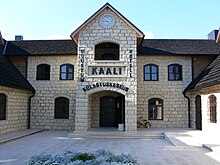Kaali (Saaremaa)
Coordinates: 58 ° 22 ′ N , 22 ° 40 ′ E
Kaali (German Sall ) is a village ( Estonian küla ) on the largest Estonian island Saaremaa . It belongs to the rural community Saaremaa (until 2017: rural community Pihtla ) in the Saare district .
Population and location
The village has 35 inhabitants (as of December 31, 2011). It is nineteen kilometers northeast of the island's capital Kuressaare .
History of the place
During the 13th century the area was given to a certain Hinrik Beckeshafwede. The village Saltowere is documented for the year 1319 . The village later became the farm that was sold to the city of Riga . In the 15th century it fell to the bishops of Saaremaa . From 1528 to 1729 the farm belonged to the noble Baltic German family Gahlen . The Estonian-speaking name of the village is derived from her family name.
In 1856, the German Baltic painter Otto Friedrich Theodor Möller (1812–1874), who was born in Kronstadt , bought the estate . The last private owner before the expropriation in the course of the Estonian land reform in 1919 was Konrad von Moeller. The primary school was built in 1936 on the foundations of the no longer preserved mansion.
Kaali meteorite crater
The place is best known today for the nine Kaali meteorite craters . The diameter of the main crater is 110 meters, its depth 22 meters. It is surrounded by a three to seven meter high wall of earth that was raised by the impact . Today there is a lake in the crater.
The eight smaller side craters are in the immediate vicinity. Corroded, sharp-edged iron fragments were also found there, which could be assigned to the most common type of iron meteorite . Charred oaks on the edge of the lake resulted in a dating of the impact in the period 500 to 900 BC.
The Estonian mining engineer Ivan Reinwald (1878–1941) verified the impact of a group of nine meteorites between 1927 and 1940 . From 1954 to 1980 Ago Aaloe (1927–1980) headed further research. A memorial stone inaugurated in 1984 commemorates both of them.
Visitor center
A visitor center opened in 2005 is located in the village. In the “Museum for Meteoritics and Limestone” there, the geological and cultural-historical investigations around the meteorite crater are clearly presented.
Prehistoric fortress
Between 1976 and 1978 the Estonian archaeologist Vello Lõugas (1937–1998) was able to prove a fortified prehistoric settlement on the shores of the lake. The pottery found there dates from the 8th to 6th centuries BC.
literature
- Baltic historical local dictionary. Part 1: Estonia (including Northern Livonia) (= sources and studies on Baltic history. Volume 8/1). Started by Hans Feldmann . Published by Heinz von zur Mühlen . Edited by Gertrud Westermann . Böhlau, Cologne / Vienna 1985, ISBN 3-412-07183-8 , p. 529.
Web links
- Description ( eestigiid.ee )
- Entry in Eesti Entsüklopeedia (online version)
- Kaali Visitor Center (German)
Individual evidence
- ↑ Estonian Statistical Office
- ^ Thea Karin: Estonia. Cultural and scenic diversity in a historical borderland between east and west. Cologne 1994 (= DuMont art and landscape guide ) ISBN 3-7701-2614-9 , p. 319




